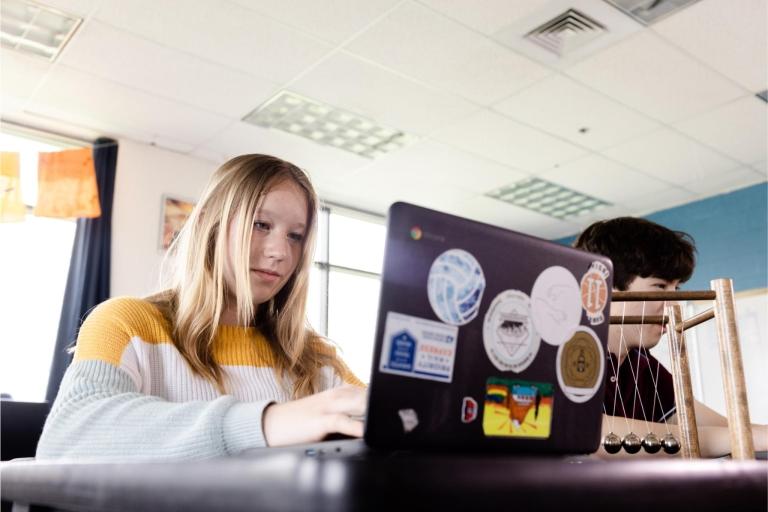
Research shows that 65% of students are visual learners. For this population of students, visual aids help them process learning concepts and materials more efficiently. However, visual learning benefits many students in both K -12 and higher education populations. This is why educators often use visuals to enhance comprehension, retention, and engagement.
With advancing technology, educators can easily implement digital visual aids in their lessons and courses. In this article, we’ll take a deeper look at visual learning, highlighting the importance of both digital and physical visual resources. In addition, we’ll explore effective strategies and best practices for implementing visual resources.
What is Visual Learning?
Visual learning is a learning style that uses imagery to communicate academic concepts and information. These visual elements often include images, charts, graphics, diagrams, etc. Visual learning is one of the primary learning styles, often associated with its counterparts, auditory and kinesthetic (hands-on) learning.
However, with visual learning, the focus is on what students can see and observe. For example, most kindergarten and first-grade classrooms utilize a word wall. The young learners use the word wall to spot sight words and build their vocabulary. Likewise, in some higher education majors, learners use graphs and diagrams to gain a deeper understanding of their studies.
Students who prefer visual resources or require visuals to learn are known as visual learners. These learners benefit from imagery and fully immersing themselves in their academic materials. Let's take a look at five ways visual students can improve their learning outcomes.

Some suggestions may require additional support or modification depending on the environment. For example, students may opt to use online resources such as digital flashcards and note-taking apps. Consider age, as younger students may need help connecting the dots between the visual resource and the learning objective. With the appropriate strategies, visual learning can enhance learning for everyone.
Strategies for Incorporating Visual Learning in Education
Educators want to ensure they utilize every opportunity to immerse learners in their studies and academic environment. Let’s take a look at visual learning strategies that can support students both inside and outside the classroom:
Provide Visual Aids in the Learning Environment: Educators use a variety of visual aids to support their teachings – these aids act as an additional learning resource. Decorate the classroom with useful infographics, diagrams, and other imagery. Teachers can also provide attached visual aids in their online courses, where students can access and download the
Utilize Interactive Visual Tools: Bring visual aids to life with interactive tools like virtual whiteboards and mind maps. This is a great way to brainstorm or even invite students to interact with the aids displayed.
Remember to Prioritize Accessibility: Create an inclusive learning environment, ensuring every student can participate and benefit from visual resources. In some cases, educators can provide textual and auditory alternatives.

Best Practices for Educators
When used effectively, visual content enriches the learning experience, not just as supplementary material but as a resource that directly aligns with academic objectives. To ensure students are receiving visual resources that support their learning goals, educators can follow these best practices:
Align Visual Content with Curriculum Goals: Use visual content to support educational standards and learning targets. Educators can strategically curate materials that reinforce academic concepts and lessons. Aligning resources with instructional material allows students to make connections – supporting their overall learning journey.
Measure the Impact of Visual Learning: Assess the effectiveness of visual learning materials by observing which aids students find useful. Educators can gauge the impact of visual resources, ensuring student understanding and comprehension improves. For additional feedback, invite students to offer feedback on visual aids and explain how the resources are used in their studies.
Continuous Improvement: With student input, educators can continue to improve the visual resources offered. In the long run, this will enhance how students interact with visual aids using digital tools and platforms.
For greater impact and accessibility, use a learning management system that supports media integration – improving the visual learning process. Let’s examine how Canvas LMS can elevate visual learning in course and instructional design.
Visual Learning with Canvas: Elevating Instructional Design
Canvas LMS offers a collection of tools and features designed to enhance and support visual learning experiences. With Canvas' seamless LTI integrations and user customization, educators can design modules and courses that engage the learner. Visual learning resources are embedded, uploaded, and linked directly into course discussions, announcements, assignments, and modules. Overall, course design is enhanced when implementing visual aids. Learn more about the importance of instructional design.
Students benefit from tailored academic experiences designed to help them succeed. With Canvas LMS, students have easy access to the visual resources they need at all times.
Digital Tools to Enhance Visual Learning
Canvas makes visual learning easier for teachers to implement, offering contributory learning resources to students. In addition to ensuring your LMS has robust tools to support visual learning, see what else you should consider when choosing an LMS.
Related Content
![teaching with tech thumbnail]() Teaching-With-Tech-10-Benefits.jpg
Teaching-With-Tech-10-Benefits.jpgBlogs
 breakingdownsilos.png
breakingdownsilos.pngBlogs
 canvas-biz-investment.jpg
canvas-biz-investment.jpgBlogs

